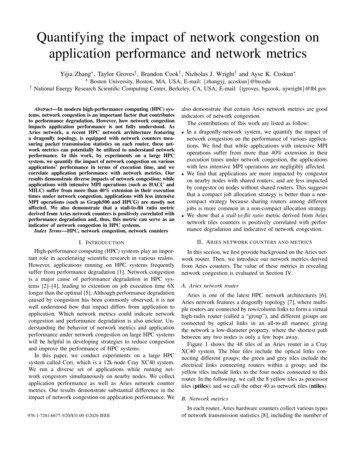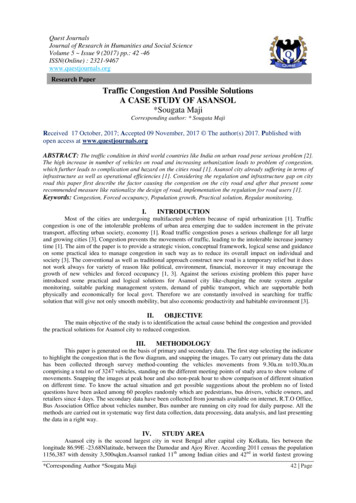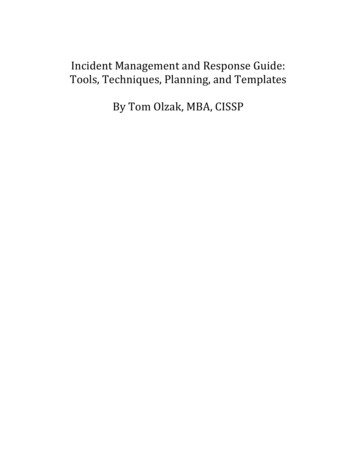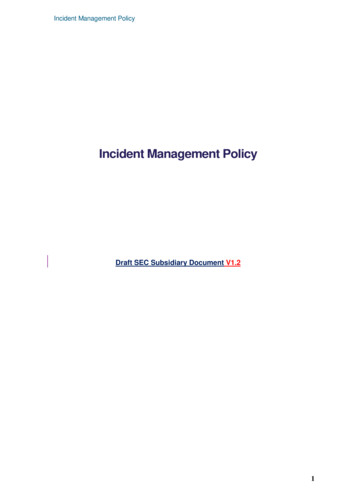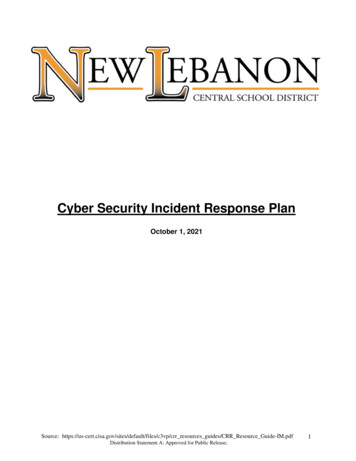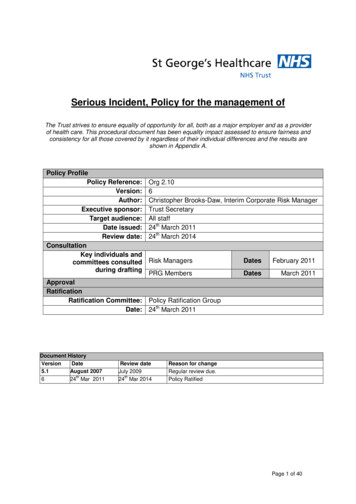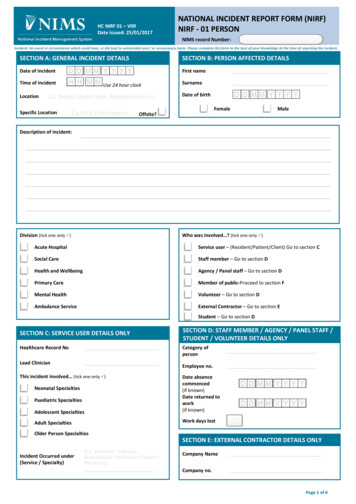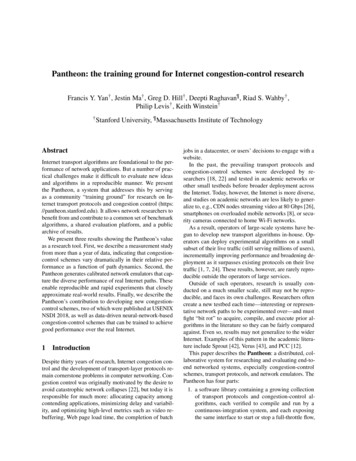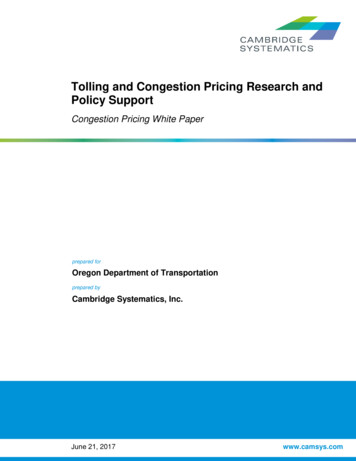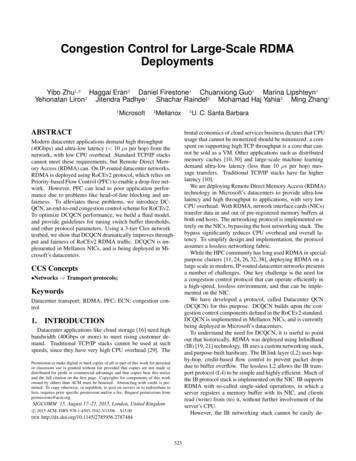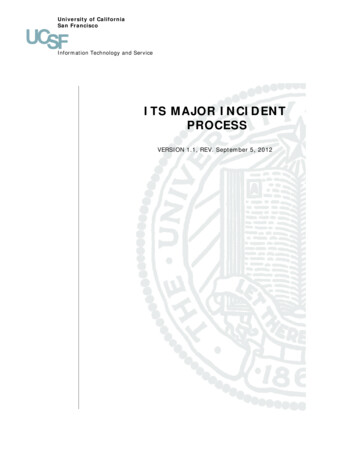
Transcription
Proceedings of the 2018 Winter Simulation ConferenceM. Rabe, A.A. Juan, N. Mustafee, A. Skoogh, S. Jain, and B. Johansson, eds.LARGE-SCALE INCIDENT-INDUCED CONGESTION:EN-ROUTE DIVERSIONS OF COMMERCIAL AND NON-COMMERCIALTRAFFIC UNDER CONNECTED AND AUTOMATED VEHICLESXiaobing LiAsad J. KhattakDepartment of Civil and Environmental EngineeringThe University of Tennessee, KnoxvilleJohn D. Tickle Building, 851 Neyland DriveKnoxville, Tennessee 37909, USAABSTRACTWhen large-scale incidents occur on freeways, en-route traffic diversion is one effective strategy toreduce the impact of incident-induced congestion. In corridors with substantial commercial traffic, e.g.,trucks, route diversion is complicated compared with non-commercial vehicular traffic, due to toughvehicle maneuvers along alternate routes, and higher safety risk. To address the issue of commercialvehicle diversions to alternate routes in response to large-scale incidents, this paper establishes amicroscopic simulation methodology to analyze the impacts of various technologies on en-route diversionunder large-scale traffic incidents in real-life corridors for single-unit and multi-unit trucks and passengervehicles. Results show, in addition to incident duration and lane blockage, important factors as CAV,incident information availability, number of intersections, AADT, impact en-route truck diversions andhence the resulting delays. In future traffic operations practice, customizing incident information to truckand passenger vehicles separately is recommended.1INTRODUCTIONUnder incident-induced congestion along the freeways, upstream travelers may react in different ways inresponse to this situation. They can either stay in the traffic queue and wait for the incident to be clearedor divert to alternative routes. In corridors with substantial commercial trucks, en-route diversion is farcomplicated compared to non-commercial vehicular traffic considering vehicle maneuvering, travel time,etc. Commercial trucks need special traffic operations in such situations, due to their weight, trafficimpact, roadway erosion, safety, energy, etc. Therefore, to make good decisions in terms of detouring,traffic information (e.g., predicted incident duration, lane blockage, current freeway and alternate routetravel time) becomes critical. En-route traffic diversion is typically deployed by Traffic ManagementCenters (TMC) besides incident site clearance under large-scale incident-induced congestion situation.However, the benefits of applying the en-route diversion strategies for commercial trucks are not wellunderstood, especially under Connected and Automated Vehicle (CAV) environment. Therefore, thispaper intends to study the benefits of applying truck en-route traffic diversions under large-scale incidentinduced congestion scenarios with CAV technology. These scenarios are based on a realistic Interstatefreeway (I-40) corridor in Knoxville area, Tennessee (TN). To be specific, this study first constructs amicroscopic simulation model to analyze en-route diversion strategies along I-40 corridors for trucks andpassenger vehicles under different incident scenarios. Secondly, this paper estimates benefits obtained byusing different traffic information penetration ratio, value of travel time (VOT), incident duration, CAV,etc. Suggestions based on the simulation results are provided at the end of this paper andrecommendations are also valuable for TN Department of Transportations (TDOT) traffic operations.978-1-5386-6572-5/18/ 31.00 2018 IEEE1132
Li and Khattak2LITERATURE REVIEWA technical report from Federal Highway Administration (FHWA) defines an alternative route as a routebegins from one point on the primary route and terminates at another point on the primary route (DunnEngineering Associates 2006). So, the alternative route for a freeway starts from an exit to alternativeroutes and then returns to the freeway on another ramp. However, most of the alternative routes cannot beused by trucks due to their weight, height, width, and turning radius. In the state of TN, alternative routesfor trucks along major freeway and highways in metropolitan areas are defined such that trucks can takecertain alternative routes upon a large-scale incident-induced freeway congestion (TDOT 2012).Unreliable travel time is identified as the most problematic outcome of incident-related congestion, whichis a significant factor for long-haul truck drivers in making route choices as they navigate through theU.S. highway network (Golob and Regan 2001; Knorring et al. 2005). Factors impacting the en-routediversion decisions include incident duration, number of blocked lanes, flow rate on routes, number ofintersections on detour route, etc. Generally, under long-duration incident scenarios, higher diversionrates can be observed (Liu et al. 2012; Liu et al. 2011; Yin et al. 2012). However, detour operations canalso cause problems on alternative routes. Even though system delay in vehicle-hours is reduced for thefreeway, delay on detour routes can increase by 64%, causing unexpected congestion in detour routes(Cragg and Demetsky 1995). This phenomena is called Braess’s paradox (Tumer and Wolpert 2000),which is caused by the distinguished difference between travelers’ perceived travel time and the systemoptimum minimized travel time pursued by traffic management team, which is very common in trafficoperations (Sheffi 1985). In terms of traffic information systems, dynamic route guidance systems (e.g.,Google Maps, GPS, 511) are found to be effective in travel time savings for passenger vehicles as well aspublic buses and trucks, especially during morning or afternoon peak hours upon non-recurrent incidents(Ng et al. 2006; Pan and Khattak 2008; Sundaram et al. 2011). However, route choice behaviors during atrip can be greatly diverse for each individual in terms of route diversions (Papinski et al. 2009).Therefore, the uncertainties within the system make the en-route diversion analysis complicated.When estimating the benefits of deploying en-route diversions, VOT should be considered. Due to theheterogeneity and uncertainty of truck industry categories, estimating VOT for each individual truck onthe road is complicated and unrealistic. Commercial trucks are studied to have much higher VOT thanpassenger vehicles, so incorporating VOT in the analysis for truck en-route diversions is necessary(Belenky 2011; Pan and Khattak 2008). However, seldom studies have focused on truck en-routediversions upon a non-recurrent large-scale incident scenario along the freeways under CAV. A largescale incident usually lasts longer than 2 hours and blocks lanes on freeways, sometimes even all the lanesare blocked (Li et al. 2017). Therefore, incident characteristics, as well as alternative route characteristics(e.g., number of lanes, AADT, number of intersections, etc.), may eventually impact the operationaldecisions made by TMC managers. Figure 1 conceptually shows a typical TMC detouring operationstrategy activated upon the traffic incidents.To sum up, by studying the en-route diversion strategies for trucks under large-scale incidentscenarios, this research aims to fill in the research gap by using simulation models to evaluate the benefitsby diverting the truck traffic as well as the passenger vehicles from freeways to arterials (namely, from I40 to Kinston Pike in Knoxville, Tennessee). This study is timely and original in the sense that truck flowgrows significantly in the state of Tennessee, and estimating the benefits in diverting the commercialtrucks to alternate route upon a large-scale incident is very important in freight traffic management.33.1METHODOLOGYNetwork and Experimental DesignThis study uses TransModeler to run the simulation analysis. TransModeler is a powerful and versatiletraffic simulation package applicable to a wide array of traffic planning and modeling tasks (Corporation2017). It can simulate all kinds of road networks, from freeways to downtown areas, to illustrate and1133
Li and KhattakIncidentDetectionDurationPredictionTraffic icationEn RouteDiversionOperation?Incident & Traffic &Inventory Data CollectionNoOutput Statistics(Travel time, Delay, TravelCost, Emissions)YesOptimal Diversion Plan(Alternative route, % of truck/cardiverted, Intersection signal plans)Avalability ofAlternativeRouteFigure 1: En-route traffic diversion operations system flowchart under the incident situation.evaluate traffic flow dynamics, traffic signal and ITS operations, and overall network performance. As fordrivers’ dynamic route choices, they are modeled based upon historical or simulated time dependenttravel times, and trips based on Origination-Destination (OD) tables. Therefore, to run the simulationanalysis, the OD matrix should be calculated as input into simulation models. To realistically reflect thereal-world operational characteristics for the study network, Enhanced Tennessee Roadway InformationManagement System (E-TRIMS), a TDOT maintained roadway information system is used to obtaintraffic data such as Annual average daily traffic (AADT), and other key variables which are grouped asfollows (see Table 1 for more details and 8 diversion locations along I-40 Eastbound exits: 369, 373, 374,376, 378, 379, 380, 383): Freeway-related variables: number of lanes on freeway mainline, AADT, percentage of passengervehicles / single-unit (SU) trucks / multi-unit (MU) trucks;Incident-related variables: number of lanes blocked, block duration, travel speed on unblockedlanes, total length of the block area; andAlternative route-related variables: AADT on two collector roads connecting freeway and arterialroad, and on the arterial road such as Kingston Pike in this study. Number of lanes andintersections, and signal timing plans on these roads.To investigate various outcomes from simulation models, a conceptual study network as well as a ODestimation graph are introduced for illustration in Figure 2. The diverted traffic includes both passengervehicles and trucks (SU – Single-Unit trucks, and MU – Multi-Unit trucks). Traffic information is veryimportant in making en-route decisions as mentioned by Sundaram et al. (2011), and Pan and Khattak(2008). If drivers are not informed of updated travel time for incidents happening on the freeway, thepotential to divert will be low. So, travel time information penetration ratio (from 0% to 100%) makes adifference in en-route traffic diversions, as well as benefit estimations in simulation analysis. Variationsin incident characteristics, VOT of trucks / passenger vehicles, as well as other variables are listed inTable 1.3.2Origination-Destination EstimationIn estimating the OD matrix for simulation analysis, 8 simplified nodes in a simplified conceptualnetwork are setup (see Figure 2). Trip productions and attractions (PAs) from Table 1 are used forgenerating OD matrix. Other data from E-TRIMS are also utilized (e.g., directional distributions ofAADT, peak hour traffic direction). The data are error checked and validated, and finally used for1134
Li and Khattakcalculating ODs. For example, for location 1, peak hour directional distribution of AADT on freeway is60% (east direction), so traffic productions for node 1 is 105,970 * 0.6 63,582, and attractions is105,970 * 0.4 42,388. Similar operations are done for location 1 to 8. Then these PAs are converted toODs in TransCAD by applying the internal gravity models. For more details on the conversion, interestedreaders can refer to (Anas 1983).Table 1: Key variables in the experimental design for the en-route diversion strategy & initialconfigurations for eight diversion locations.VariablesDescriptionRange of ValuesFr LnFr AADTNumber of main lanes each direction on freewayAADT on freewayFr PerPCPercentage of passenger vehicles on freewayFr PerSUFr PerMUPercentage of single-unit trucks on freewayPercentage of multi-unit trucks on freewayInc LnInc BlcDurInc SpeedInc lengthAlt Col1AADTNumber of lanes blocked during incidentIncident blockage durationTravel speed on available travel lane on freewayTotal length of the blockage during incidentAADT on collector road 1 from freeway to arterialAlt Col2AADTAADT on collector road 2 from arterial to freewayAlt AADTAADT on alternative arterialAlt Col1 LnNumber of lanes each direction on collector road 1 fromfreeway to arterialNumber of lanes each direction on collector road 2 fromarterial to freewayNumber of lanes each direction on alternative arterialNumber of signalized intersections on alternative routeAlt Col2 LnAlt LnAlt Int3, 4, 5105,970, 119,300, 136,250, 179,910,188,060, 196,210, 196,71070%, 72%, 74%, 76%, 77%, 78%, 80%,81%, 83%, 84%, 87%, 88%, 89%2%, 3%, 4%, 5%, 6%8%, 9%, 10%, 11%, 12%, 14%, 15%, 16%,17%, 18%, 21%, 25%, 27%3, 4, 5 2 hours10 mph, 15mph200, 300, 400, 500, 60010,740, 27,840, 41,820, 63,990, 19,500,11,420, 19,450, 27,28427,840, 41,820, 63,990, 19,500, 11,420,12,550, 14,360, 77,42022,570, 29,340, 28,760, 31,090, 19,170,247491, 2, 3, 41, 2, 3, 42, 3, 4, 52, 3, 4, 71111910153.3Traveler Information and VOTIn evaluating the impact of traveler information on en-route diversion strategies, information penetrationratio is set up to vary from 0% to 100%. For each group of drivers from the vehicle fleet passenger cars PC, SU, or MU, they either receive updated travel time information or not in TramsModeler. For thosewho do not receive updated travel time information, they remain in the current traffic in TransModelersimulation models; otherwise, they can take the designated alternative route based on the threshold value(5%) of the travel time difference between freeway and alternative route.1135
Li and KhattakIncident locationFreewayDiversion PointBoth truck and passengervehicle trafficIntersectionArterialMerge 78IntersectionFigure 2: En-route diversion scheme along the freeway & ODs for the study network.3.4En-Route Choice ModelStochastic shortest path method based on path costs is adopted in this study. Compared to deterministicshortest path method, it takes account the variations in each individual drivers’ perception and behavioron pre- and en-route choices. Thus, path costs are randomized and there could be many shortest pathsbetween a given O-D pair. TransModeler is a path-based simulation model (Caliper 2014), so eachvehicle has an assigned path before departing its origin and entering the network. Simulated vehicles willconsider en-route alternative paths if delay experienced on a link far exceeds expected delay which isobtained though dynamic traffic assignment using stochastic user equilibrium method computed by themethod of successive averages (MSA) in TransModeler. The threshold for link delay to be consideredexcessive is determined by each drivers’ route choice parameters (e.g., choice set threshold, update delaythreshold, reroute threshold). These parameters often vary among the driving population, and theyeventually determine drivers’ decisions on the alternative paths. Some of the key en-route choiceparameter are presented as: 4Informed – access to updated travel time information. Drivers make all en-route choice decisionssolely based on historical travel time if no informed.Update delay threshold – the percent difference between experienced travel time on a link relativeto expected or historical travel time. Drivers may or may not take alternative paths if threshold isexceeded. 20% is used in this study as the update delay threshold.Reroute threshold – the percentage reduction in travel time relative to the current path required indeciding to switch to the alternative route. 5% is chosen for PC, while for SU/MU, 10% is usedsince truck drivers’ preference will often be freeway instead of other local arterials, especially forlong-haul trucks.SIMULATION ANALYSIS RESULTSDelay statistics is mostly used among various criteria (e.g., travel time, Level of Service, intersectionsstops, queue length) in evaluating the performance of en-route diversion traffic operations strategy (Dunn1136
Li and KhattakEngineering Associates 2006; Knorring et al. 2005; Liu et al. 2011; Liu et al. 2012; Yin et al. 2012; Ng etal. 2006; Pan and Khattak 2008). Delay reductions can be treated as travel time savings, and delayreductions of trucks and passenger vehicles can also be converted to savings in emissions, fuel, as well asmonetary value. The simulation runs start at 00:00:00 and end at 23:59:59, and incidents are assumed toblock all other lanes except one lane on the left side of the freeway, and the travel speed is assumed to be10 mph for this available travel lane. The incident is set up during morning peak hours from 7 to 9 AMfor simulation analysis.4.1Delay OutcomesFigure 3 presents the delay statistics for freeway and alternative routes at 8 locations under differenttraffic information penetration rate. Those 8 locations are located from rural to urban (1 – 8). Figure 3(Left) shows the delay statistics for the freeway. Compared to normal traffic situation, if an incidentoccurs on the freeway and 0% of the drivers in the fleet are informed of the updated travel time, theaverage delay increased about 4.6 to 8.7 times for freeway diversion points at 8 locations. These statisticsindicate a driver will spend 20 - 45 minutes to drive through the segment where normally 5 minutes isenough for the travel. Figure 3 (Left) presents delay reductions for the freeway based on the percentage ofdrivers in each fleet group having access to traffic information. The results show that with more trafficinformation delivered to drivers, the en-route diversion rate will increase, and the travel delay reductionwill be more. Additionally, under CAV environment, the simulation results show that, traffic on thefreeway, if taking en-route diversions from the freeway to alternative arterials at rural locations can savemore travel time compared to non-CAV vehicles, because these CAV vehicles can quickly react toincidents with real-time traffic information. The preliminary analysis graphs do reveal a monotonicincreasing benefit from the average delay reductions for freeway (up to 8% - 10% at 8 locations) and amonotonic average delay increment for an alternative route (up to 10% - 20% at 8 locations, Figure 3(Right)). This interesting result indicates that with more traffic related information delivered to drivers,they can quickly respond to the incidents, which generally contributes the overall freeway congestionrelief and improve their driving experience. Notice in Figure 3 (Left), compared to rural locations (e.g.,location 1 & 2), average delay reductions at urban locations are less. It is probably due to that drivers aturban areas prefer to stay on the freeway since the alternative routes might also be congested at morningpeak hour. Therefore, considering the number of intersections and a high chance of long intersectiondelays, drivers, especially truck drivers still consider the freeway as their primary route choice. While inrural areas, fewer intersections are observed, which might not cause much delay in rural areas. Thisimplies that under heavily congested areas (e.g., downtown area), regardless of traffic information,freeway is still the primary route choice due to high congestion in peak hour as well as tough vehiclemaneuvers (e.g., lane changing, merging, diverging, turning).Figure 3: Average delay reductions for freeway at 8 locations (Left); Average delay reductions foralternative route at 8 locations (Right).1137
Li and Khattak4.2Impact of Value of Travel TimeAssuming 50% of the drivers are updated with traffic information. The impact of VOT on delay reductionis evaluated. Assuming VOT for passenger vehicles is 15 (for illustration purpose only), and VOT fortrucks (SU and MU) are set up as 2, 4, 6, 8, 10, and 12 times greater compared to passenger vehicles. Ifonly considering the freeway or detour route separately, then simulation analysis results show that delayreductions for freeway or increments for detour route are not very stable. If both are analyzed together,then delay reduction is much more stable. Higher VOT means higher risk in increasing travel cost if nottaking a proper alternative route, so most truck drivers prefer the freeway. If converting travel timesavings to dollars using conversion factors in Table 2, results in Figure 4 indicate that comparted to basedcase ( 15 VOT for all vehicles), the overall travel cost savings in percentage declines, even though thetotal amount of travel cost savings increases. This result implies that when en-route diversion operationsare implemented, diverting trucks as well as passenger vehicles is necessary because trucks usually havehigher VOT, which contributes to higher total cost savings. However, if the VOT of trucks is way higher,diverting more truck traffic won’t increase much in terms of percentage travel time savings.Figure 4: Travel cost savings under different trucks VOTs.4.3Impact of Incident DurationsThe impact of incident duration is evaluated by studying location 8 in detail. The peak hour direction forI-40 is Eastbound. The alternative diversion route starts from I-40 Exit 383 to Northshore Drive toKingston Pike to State Route 129, then back to I-40 at 386B. Under normal traffic conditions, travel timeon the segment is 4 minutes for 4.3 miles. It is about 13 minutes for 5.6 miles if driving on Kingston Pikewith 15 signalized intersections. Figure 5 presents the delay reduction information for the whole studynetwork by assuming 50% of the travelers are updated with traffic information, and incidents start at 7Figure 5: Total delay with updated traffic information under large-scale incident scenarios lasting 2 to 6hours.1138
Li and KhattakAM and last 2 to 6 hours. Only one lane is assumed to be available for travel at the incident sitethroughout the whole simulation runs under large-scale incident scenarios lasting 2 to 6 hours. Delayreductions are seen to increase as incident duration lasts longer.4.4Benefit EstimationBenefit estimation can be extended to emission and fuel reductions. Together these savings can beconverted to monetary values using the conversion factors in Table 2. Using conversion factors in Table2, the cost savings are obtained for the incident scenarios lasting from 2 to 6 hours (see Table 3). Resultsclearly show that with longer incident durations, the benefit of cost savings (in delay, emissions, and fuel)is greater. This result is in accordance with other studies (Chang and Raqib 2013; Liu et al. 2012; Lutseyet al. 2004), and under such large-scale incident scenarios, the magnitude of the cost savings is muchlarger than non-large incident scenarios.Table 2: Conversion factors and their sources.Conversion NameValueSourceDelay to HCDelay to CODelay to NODelay to CO213.073 g/h146.831 g/h6.261 g/h0.156 gal/h of passenger cars0.85 gal/h of trucks19.56 lbs/gal of gasoline22.38 lbs/gal of diesel 27.37/h 2.264/gal of gasoline (East Coast) 2.546 gal of diesel (East Coast) 6,700/ton ( 6.7/kg) 6,360/ton ( 6.36/kg) 12,875/ton ( 12.875/kg) 23/metric ton ( 0.023/kg)Chang and Raqib (Chang and Raqib 2013)Chang and Raqib (Chang and Raqib 2013)Chang and Raqib (Chang and Raqib 2013)Ohio Air Quality Development Authority(Lutsey et al. 2004)Chang and Raqib (Chang and Raqib 2013)CO2Delay CostFuel CostHC costCO costNO costCO2 costU.S. Census Bureau 2009Energy Information AdministrationChang and Raqib (Chang and Raqib 2013)Chang and Raqib (Chang and Raqib 2013)Chang and Raqib (Chang and Raqib 2013)Chang and Raqib (Chang and Raqib 2013)Table 3: Cost saving for large-scale incident CostSaving 31,015 55,941 57,997 67,469 85,156Fuel CostSaving 790.13 1,425 1,477 1,718 2,169HCCostSavingCOCostSaving 99 179 185 215 272 1,058 1,908 1,978 2,302 2,905NOCostSaving 91 164 170 198 250CO2CostSaving 71 129 134 156 197Total CostSavings 33,126 59,748 61,944 72,061 90,952Impact of CAV on Network PerformanceVehicle automation has made the progress in improving the surface transportation in terms of mobilityand safety. However, seldom has the current existing studies focused their attention on estimating thebenefits under the en-route traffic diversion under large-scale traffic incident on the freeways. Thus, theimpact analysis of CAVs on network performance in terms of travel delay reductions and average speed,is done to compare the difference between the benefit estimations under various vehicle automation levelsand under normal driving conditions with drivers fully controlling the vehicles. Traditionally, the traffic ismodeled in the TransModeler using General Motors (GM) car-following models, and its formulationbased on TransModeler User’s Guide version 5.0 is written as following Equation (1),1139
Li and Khattak𝐴 𝑖 [𝑡𝛽 𝑡] 𝛼 𝑉𝑖[𝑡]𝛽 𝐷𝑖,𝑖 1 [𝑡] (𝑉𝑖 1 [𝑡] 𝑉𝑖 [𝑡])𝜃 𝜀𝑖𝐶𝐹(1)Where:𝐴 𝑖 [𝑡 𝑡] Acceleration rate of vehicle 𝑖 at time reaction time 𝑡;𝑉𝑖 [𝑡] Speed of subject vehicle 𝑖 at time 𝑡;𝑉𝑖 1 [𝑡] Speed of front vehicle 𝑖 1 at time 𝑡;𝐷𝑖,𝑖 1 [𝑡] Distance between the vehicle 𝑖 and front vehicle 𝑖 1 at time 𝑡;𝛼 , 𝛽 , 𝛾 , 𝜃 Model Parameters; means acceleration, and – means deceleration.𝜀𝑖𝐶𝐹 vehicle-specific error term for the car-following regime.The acceleration of the subject vehicles happens when its speed is less than the speed of the frontvehicle. Otherwise, the subject vehicle will remain constant or decelerate. Lower bound and upper boundof headway are set to limit the vehicles running above the emergency regime and under the free flowregime.However, under the CAV environment, it is suggested to run the Constant Time Gap car-followingmodel (CTG) to achieve the goal of improving transportation mobility by increasing roadway capacityand travel speed. It follows the concept that drivers seek to maintain a constant, desired followingheadway with the front vehicle. It is more like a simplified algorithm representing an on-boardcomputer’s operating policy. Thus, it can be used to approximate the behaviors of connected vehicles in acooperative adaptive cruise control environment. Its formulation based on TransModeler User’s Guideversion 5.0 is written as Equation s(2),1𝐴𝑖 [𝑡] ℎ (𝑉𝑖 [𝑡] 𝑉𝑖 1 [𝑡] 𝜆𝛿𝑖 ){𝑑𝑒𝑠𝑖𝑟𝑒𝛿𝑖 [𝑡] 𝐷𝑖,𝑖 1 [𝑡] ℎ𝑉𝑖 [𝑡] 𝐷𝑖,𝑖 1(2)Where:𝐴𝑖 [𝑡] Acceleration rate of vehicle 𝑖 at time 𝑡;ℎ Desired following time headway (in seconds);𝑉𝑖 [𝑡] Speed of subject vehicle 𝑖 at time 𝑡;𝑉𝑖 1 [𝑡] Speed of front vehicle 𝑖 1 at time 𝑡;𝛿𝑖 Spacing error for vehicle 𝑖 requiring correction to achieve the desired headway ℎ;𝐷𝑖,𝑖 1 [𝑡] Distance between vehicle 𝑖 and vehicle 𝑖 1 at time 𝑡;𝜆 Model parameter for control purpose.Various scenarios are created to evaluate the impact of CAV on the network performance based onlocation 8. First, one of the roadway segments in the simulations models are extracted to compare thesimulated traffic flows and realistic traffic flows. By doing so, the simulation model is validated to haverepresented more realistically about the I-40 and Kingston Pike traffic flow conditions. The segmentwhere traffic entered the freeway network is used. The hourly volume for realistic traffic on this segmentis shown to be 4918/hour. Using the Mean Absolute Percentage Error (MAPE) measurement, theaveraged value of MAPE for simulated traffic volume and realistic traffic volume is 3.55% based on 70simulations without any incident. It is an acceptance value, because 5% is usually used for the gapacceptance in TransModeler.Figure 6 presents the simulation outcomes in terms of total network system delay. A huge change ofdelay from no automation to level 1 automation. 1.5% - 13% reduction in total delay with incidentdurations ranging from 675 to 0 minutes. By setting the headways (1.1, 1.0, 0.9, 0.7, 0.6, and 0.5 inseconds) in the 5 automation levels, the scenarios present a monotonically decreasing trends for total1140
Li and Khattaksystem delay. With less headways between vehicles, the roadway has more capacity, so vehicles spendless travel time in the system. However, after automation level 3, the benefit obtainment is less whencompared to lower automation levels. Overall, by deploying the CAV technology into such en-routetraffic diversion operation, the traffic network save more travel time. In addition, the impact of truckperformance under various automation levels are also investigated, and the results are shown in Figure 7.It indicates that the network performance can be increased by introducing higher performance trucks aswell as passenger vehicles. Maximum percentage increase in average speed can be as large as 18.29%when vehicle performance increases by 15% at level 5 automation. Therefore, to sum, both CAV andvehicle performance, especially CAV, play important roles in improving traffic network performanceunder large-scale incident induced traffic congestion on freeways.Figure 6: Simulation outcomes in term of system delay with no incidents under 5 levels of automation.Figure 7: Avg. speed with no incidents based on truck vehicle performance under 5 levels of automation.5CONCLUSIONSEn-route traffic diversion operation is one of the traffic calming strategies to deal with traffic incidents.However, seldom research has been done to specifically talking about such diversions under nonrecurrent large-scale incident situations for commercial trucking vehicles. Large-scale incidents usuallylast longer and block more
A technical report from Federal Highway Administration (FHWA) defines an alternative route as a route . certain alternative routes upon a large-scale incident-induced freeway congestion (TDOT 2012). . trucks / multi-unit (MU) trucks; Incident-related variables: number of lanes blocked, block duration, travel speed on unblocked lanes .
